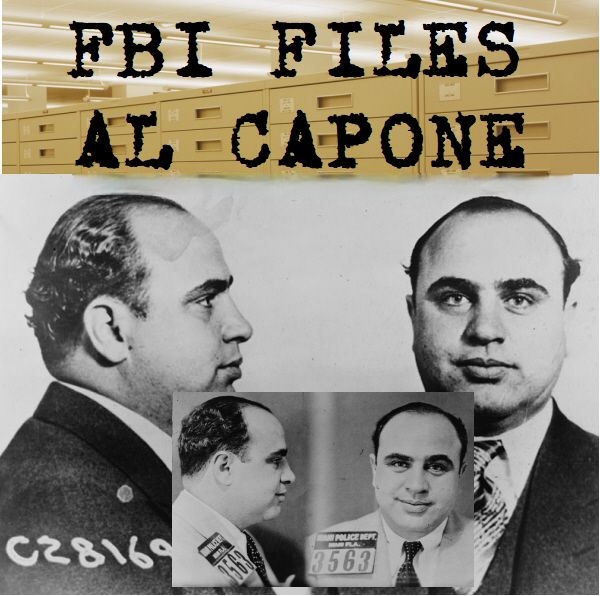
AL Capone FBI, Bureau of Prisons, IRS, United States Attorney Files, Newspapers & Books
$19.50
Description
Al Capone: Timeline and Key Figures
This timeline focuses on events primarily related to Al Capone and the broader context of organized crime in Chicago and the United States, as detailed in the given sources.
- 1926 (April 29): Early newspaper coverage of Al Capone begins, as evidenced by the date range of the “Newspapers” collection.
- 1927: George E.Q. Johnson begins his tenure as the United States District Attorney for the Northern District of Illinois.
- 1929:March 5: Al Capone’s lawyers file an affidavit claiming he is suffering from bronchial pneumonia in Miami to postpone his appearance before a Federal Grand Jury.
- Early March (approx.): FBI investigation reveals Capone attended racetracks, took a plane trip to Bimini, cruised to Nassau, and appeared in good health when interviewed by the Dade County Solicitor, contradicting his affidavit.
- March 20: Al Capone appears before the Federal Grand Jury in Chicago.
- March 27: Al Capone completes his testimony before the Federal Grand Jury and is immediately arrested by agents for contempt of court as he leaves the courtroom. He posts a $5,000 bond and is released.
- February 14: The St. Valentine’s Day Massacre occurs in Chicago, an event explicitly covered in the FBI files related to Capone.
- May 17: Al Capone and his bodyguard are arrested in Philadelphia for carrying concealed deadly weapons. They are sentenced to one year each within 16 hours.
- Unknown Date: John Landesco’s monograph “Organized Crime in Chicago,” part of “The Illinois Crime Survey,” is published, detailing the interlocking interests of gambling, bootlegging, vice, and politics in Chicago.
- Unknown Date: Armitage Trail writes the novel “Scarface,” heavily inspired by Al Capone’s life, which is published in 1930.
- Throughout 1929-1932: George E.Q. Johnson compiles his scrapbooks, documenting his professional and personal life, including the prosecution of Al Capone and other Chicago criminals.
- 1930:March 17: Al Capone is released from prison after serving nine months of his one-year sentence for good behavior (from the Philadelphia arrest).
- Unknown Date: The booklet “Chicago Gang Wars in Pictures: X Marks the Spot” is published, documenting the Chicago underworld of the 1920s and early 1930s with period photographs.
- 1931:The IRS Intelligence Unit uses an undercover agent to gather evidence against Al Capone.
- Al Capone is convicted of tax evasion and sentenced to 11 years in federal prison, a $50,000 fine, and ordered to pay $215,000 plus interest on back taxes.
- 1932: George E.Q. Johnson’s term as United States District Attorney for the Northern District of Illinois concludes.
- 1933: Roger Touhy is framed for the faked kidnapping of John “Jake the Barber” Factor.
- 1934:Al Capone writes a handwritten letter to the warden of the United States Penitentiary at Atlanta, seeking improvements in privileges.
- The Federal Bureau of Prison files begin, dating from this year.
- 1936:February 28: Al Capone is found guilty in Federal Court on the contempt of court charge (from 1929) and sentenced to six months in Cook County Jail.
- Unknown Date: Al Capone’s mother, Theresa Capone, sends a handwritten letter to Sanford Bates, director of the Federal Bureau of Prisons, concerning attempts on her son’s life in Alcatraz.
- 1938:June: An Alcatraz neuro-psychiatric examination report diagnoses Capone as having, “Psychosis with General Paralysis of the Insane: Expansive type.”
- Unknown Date: Al Capone sends a typed letter to his son, Al Jr., then a student at Notre Dame University.
- 1939:January 17: Al Capone is transferred from Alcatraz to Terminal Island Federal Prison; a psychiatric examination report is conducted.
- September 13: A second Terminal Island Prison psychiatric examination report is conducted on Capone, shortly before his release.
- The Federal Bureau of Prison files end, dating to this year.
- 1951: The Kefauver Committee Report on Organized Crime is published, determining the existence of a “sinister criminal organization” (later known as La Cosa Nostra) in the United States.
- 1959:Roger Touhy’s autobiography, “The Stolen Years,” written in prison, is published.
- John Factor sues Roger Touhy for libel due to statements in “The Stolen Years.”
- November: Roger Touhy is released from prison.
- Less than a month after November release: Roger Touhy is murdered by the Chicago Outfit.
- 1962: Irving Kupcinet’s book “Kup’s Chicago,” containing an excerpt dealing with Al Capone, is published.
- 1963:J. Campbell Bruce’s book “Escape from Alcatraz; a Farewell to the Rock” is published, shortly after Alcatraz ceases to be a federal penitentiary.
- October 2: The latest date of newspaper coverage on Al Capone, as indicated by the “Newspapers” collection.
Cast of Characters
This list includes principle people mentioned across the provided sources, with brief bios.
- Alphonse “Al” Capone: The central figure of the sources. A notorious American gangster and prohibition-era bootlegger from Chicago. He was famously known by the nickname “Scarface.” He faced investigations by the FBI for racketeering, was convicted of contempt of court and for carrying concealed weapons, but most notably, was convicted of tax evasion, leading to an 11-year federal prison sentence. He served time in Atlanta, Alcatraz, and Terminal Island, where his declining health due to “Psychosis with General Paralysis of the Insane” was documented.
- Theresa Capone: Al Capone’s mother. She wrote to the Director of the Federal Bureau of Prisons concerning attempts on her son’s life in Alcatraz in 1936.
- Al Capone Jr.: Al Capone’s son. He was a student at Notre Dame University in 1938 when his father wrote him a letter from prison.
- Frank Capone: Al Capone’s brother, also mentioned in the FBI files.
- Ralph Capone: Al Capone’s brother, also mentioned in the FBI files.
- Frank Nitti: An associate or high-ranking member of Al Capone’s organization, mentioned in the FBI files.
- George E.Q. Johnson: United States District Attorney for the Northern District of Illinois from 1927-1932. He compiled scrapbooks documenting his work, especially related to the prosecution of Al Capone and other Chicago-area criminals.
- Sanford Bates: Director of the Federal Bureau of Prisons in 1936, who received a letter from Theresa Capone concerning her son’s safety.
- Frank J. Wilson: An IRS Special Agent, known as the “father of forensic accounting.” He was instrumental in gathering evidence against Al Capone for tax evasion, with letters and reports from him included in the IRS records.
- John Landesco: A sociologist (1890-1954) and research assistant for the American Institute of Criminal Law and Criminology. He authored “Organized Crime in Chicago” (1929), detailing the connections between crime, vice, gambling, bootlegging, and politics in Chicago, with numerous mentions of Capone.
- Armitage Trail: Author of the 1929 novel “Scarface,” published in 1930, which was heavily inspired by the real-life Al Capone. He died suddenly in 1930.
- Tony “Scarface” Guarino: The fictional protagonist of Armitage Trail’s novel “Scarface,” whose rise and fall in Chicago’s illegal alcohol business during Prohibition mirrors Al Capone’s life.
- Al Springola: A fictional mob leader in “Scarface” who is killed by Tony “Scarface” Guarino.
- Roger Touhy: An Irish American mob boss and prohibition-era bootlegger from Chicago, and a rival of Al Capone. He was framed for the 1933 faked kidnapping of John “Jake the Barber” Factor and spent 26 years in prison. He authored the autobiography “The Stolen Years” (1959) and was murdered by the Chicago Outfit shortly after his release.
- John “Jake the Barber” Factor: A gangster and brother of cosmetics manufacturer Max Factor Sr. He was involved in a faked kidnapping in 1933 for which Roger Touhy was framed. He later sued Touhy for libel over statements in “The Stolen Years.”
- Estes Kefauver: A Democrat Senator from Tennessee who led a U.S. Senate committee in 1951 (The Kefauver Committee) that investigated organized crime in interstate commerce and identified a “sinister criminal organization” (later known as La Cosa Nostra).
- Irving Kupcinet (“Kup”): An American newspaper columnist for the Chicago Sun-Times, television talk-show host, and radio personality. His 1962 book “Kup’s Chicago” includes an excerpt about Al Capone.
- J. Campbell Bruce: Author of “Escape from Alcatraz; a Farewell to the Rock” (1963), a book about the history of Alcatraz that mentions Capone.
AL Capone FBI, Bureau of Prisons, IRS, United States Attorney Files, Newspapers & Books
This collection contains a total of 6,176 pages
This collection includes:
FBI Files
3,656 pages of files copied from FBI Headquarters in Washington, D.C., covering Alphonse Capone. Files contain memos, letters from the public, miscellany, and newspaper articles. Files chiefly cover racketeering at produce markets in Chicago; Special favors Al Capone received while in federal prison in Atlanta; accounts of bribed prison officials; Capone’s transfer to and stay at Alcatraz; and Capone’s contempt conviction.
Scope and Content of FBI Files
In 1929, the FBI was ordered by the Attorney General to investigate the legitimacy of an affidavit that petitioned for a postponement of Capone’s appearance in response to a Federal Grand Jury subpoena. His lawyers formally filed for postponement of his appearance, submitting a physician’s affidavit dated March 5, which attested that Capone, in Miami, had been suffering from bronchial pneumonia.
The FBI obtained statements to the effect that Capone at that time had attended racetracks in the Miami area, that he had made a plane trip to Bimini and a cruise to Nassau, and that he had been interviewed at the office of the Dade County Solicitor, and that he had appeared in good health on each of those occasions. Capone appeared before the Federal Grand Jury at Chicago on March 20, 1929, and completed his testimony on March 27.
As he left the courtroom, he was arrested by agents for contempt of court, an offense for which the penalty could be one year and a $1,000 fine. He posted $5,000 bond and was released. On May 17, 1929, Al Capone and his bodyguard were arrested in Philadelphia for carrying concealed deadly weapons. Within 16 hours they had been sentenced to terms of one year each. Capone served his time and was released in nine months for good behavior on March 17, 1930.
On February 28, 1936, Capone was found guilty in Federal Court on the contempt of court charge and was sentenced to six months in Cook County Jail.
The files also contain coverage of the St. Valentine’s Day Massacre, Frank and Ralph Capone, and Frank Nitti.
Federal Bureau of Prison Files
25 pages of files, dating from 1934 to 1939, selected from holdings at the National Archives at San Francisco in San Bruno, California.
Files include:
A 1934 handwritten letter from Capone to the warden of the United States Penitentiary at Atlanta, seeking improvements in privileges.
Handwritten Western Union telegram message blanks of telegrams Capone sent to his mother and wife.
A 1936 handwritten letter from Al Capone’s mother, Theresa Capone, to Sanford Bates, director of the Federal Bureau of Prisons, concerning attempts on her son’s life in Alcatraz.
A typed 1938 letter from Capone to his son Al Jr., then a student at Notre Dame University.
A June 1938 Alcatraz neuro-psychiatric examination report diagnosing Capone as having, “Psychosis with General Paralysis of the Insane: Expansive type.”
Two Terminal Island Prison psychiatric examination reports on Capone, one from January 17, 1939, when he was transferred from Alcatraz to Terminal Island Federal Prison, and another from September 13, 1939, shortly before his release from prison.
IRS Al Capone Records
86 pages of Internal Revenue Service (IRS) documents related to Al Capone. In 1931 the IRS Intelligence Unit used an undercover agent to gather evidence against Al Capone. Capone was convicted of tax evasion and sentenced to 11 years in federal prison, a $50,000 fine, and ordered to pay $215,000 plus interest on back taxes.
Includes letters from and reports by IRS Special Agent Frank J. Wilson known was the “father of forensic accounting.”
George E.Q. Johnson Scrapbooks
Four scrapbooks containing 641 pages compiled and maintained by George E. Q. Johnson, the United States District Attorney for the Northern District of Illinois from 1927-1932. The books cover the years 1929-1932. The scrapbooks include clippings from newspapers across the country of articles relating to the professional and personal life of Johnson. Many articles relate to the prosecution of Al Capone as well as other Chicago-area criminals.
Newspapers
422 full-sheet newspaper pages dating from April 29, 1926, to October 2, 1963, with coverage of Al Capone. Dozens of newspapers From Alaska’s Nome Nugget to Florida’s Key West Citizen, billed as the southernmost newspaper in the U.S.A.
Books
Organized Crime in Chicago by John Landesco (1929)
Part three of the three part The Illinois Crime Survey, this 292-page monograph was written by sociologist John Landesco (1890-1954) who was educated in Chicago public schools and at the Universities of Wisconsin and Cincinnati, he later received a Ph. B. in Sociology from the University of Chicago in 1923. As research assistant for the American Institute of Criminal Law and Criminology, Landesco began his study of organized crime, which was financed jointly by the Carnegie and Rockefeller Foundations. The results of Landesco’s first two years of intensive study were published as part of the Illinois Crime Survey in 1929, titled Organized Crime in Chicago.
The book has 203 mentions of Capone.
Abstract: The survey of organized crime deals with the principal sources of the crimes of violence in the city of Chicago. It discloses a startling and amazing story of the interlocking interests of gambling, bootlegging, vice, and politics. Back of this organized crime and this organized corruption is syndicated vice, syndicated gambling, syndicated prostitution, and syndicated liquor selling. Back of all this is the philosophy and the environment which creates youthful criminals, for the criminal career is progressive and usually the first offense was but a gesture of boyhood and comparatively trifling in its nature. A crime is but a rebellion against organized society and the laws under which organized society has chosen to be ruled and governed. A criminal career is a misdirected career; usually there is to be found some fundamental reason for this rebellion and for this misdirection.
Scarface (Novel) (1929)
A copy of Scarface a novel written by Armitage Trail in 1929 and published in 1930. The twenty-eight-year-old author died suddenly of a heart attack in 1930. The 1932 film Scarface was based on it.
The book’s storyline is heavily inspired by the real-life Al Capone whose nickname was also “Scarface”. It concerns the rise and fall of Tony “Scarface” Guarino, who after performing a hit on mob leader Al Springola, moves in to take over the illegal alcohol business in Chicago during the Prohibition Era. He is ultimately shot dead by his brother (who concurrently rises in the ranks of Chicago PD), who fails to recognize him due to the family believing him to have died in World War I.
Chicago Gang Wars in Pictures: X Marks the Spot (1930)
A 68-page booklet heavily illustrated with period photographs, often of mobsters slained gangland style, covering the Chicago underworld of the 1920’s and early 1930’s.
The Kefauver Committee Report on Organized Crime (1951)
Final Report of the Special Committee to Investigate Organized Crime in Interstate Commerce, 1951. It was not until 1951 that a U.S. Senate committee led by Democrat Estes Kefauver of Tennessee determined that a “sinister criminal organization,” later known as La Cosa Nostra, operated in the United States. The report makes 95 mentions of Capone.
The Stolen Years, by Roger Touhy with Ray Brennan (1959)
Roger Touhy’s autobiography, written in prison, published months before his murder by the Chicago Outfit.
Roger Touhy (1898–1959) was an Irish American mob boss and prohibition-era bootlegger from Chicago, who was a rival of Al Capone. He is also known for having been framed for the 1933 faked kidnapping of gangster John “Jake the Barber” Factor, a brother of cosmetics manufacturer Max Factor Sr. Despite numerous appeals and at least one court ruling freeing him, Touhy spent 26 years in prison. While in prison, Touhy sued 20th Century Fox for libeling him in the motion picture “Roger Touhy, Gangster.” The parties settled out of court, with Touhy receiving $15,000 in damages.
Touhy’s autobiography, The Stolen Years, was published in 1959. John Factor sued Touhy for libel for the statements published in the book. Touhy was released from prison in November 1959 and murdered by the Chicago Outfit less than a month later.
Kup’s Chicago (1962) (Excerpt) by Irving Kupcinet
An excerpt from Irving Kupcinet’s 1962 book Kup’s Chicago dealing with Al Capone.
Irving Kupcinet was an American newspaper columnist for the Chicago Sun-Times, a television talk-show host, and radio personality based in Chicago, Illinois. He was popularly known by the nickname “Kup”. His daily “Kup’s Column” was launched in 1943 and remained a fixture in the Sun-Times for the next six decades.
Escape from Alcatraz; a Farewell to the Rock, by J. Campbell Bruce (1963)
J. Campbell Bruce’s book about the history of Alcatraz has been referred to as a true crime classic. Published soon after the last prisoner left Alcatraz and it ceased being a federal penitentiary in 1963, it contains mentions of Capone throughout.
Related products
-
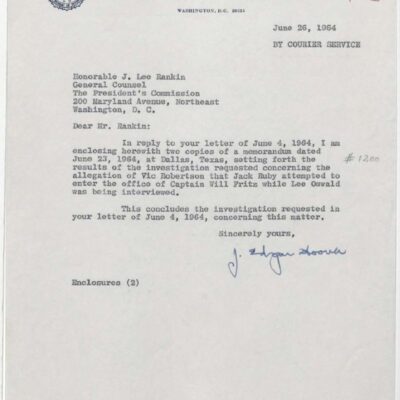
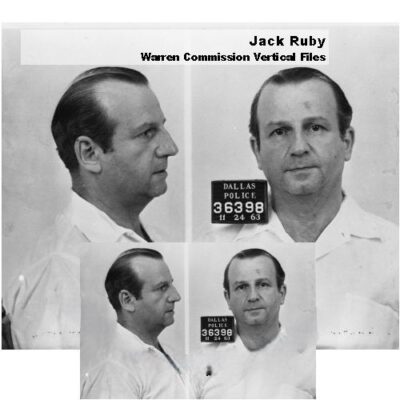
JFK Assassination Jack Ruby Warren Commission Vertical Files
$19.50 Add to Cart -
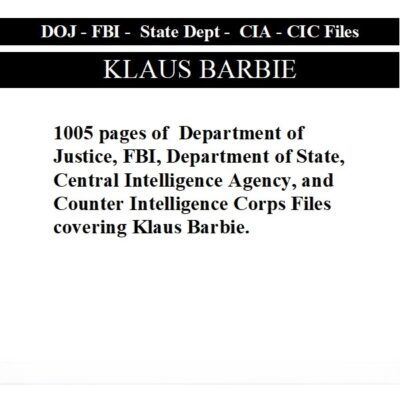
Klaus Barbie: Department of Justice – FBI – Counter Intelligence Corps Files
$19.50 Add to Cart -
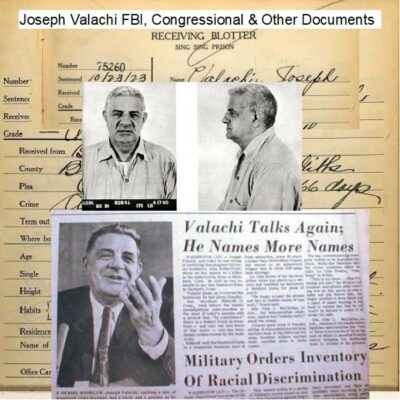
Joseph Valachi FBI Files – Congressional Hearings & Other Historical Material
$19.50 Add to Cart -
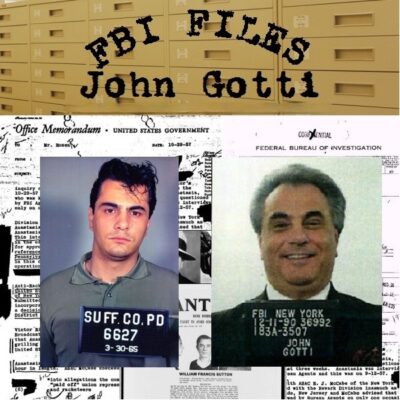
John Gotti FBI Files
$19.50 Add to Cart